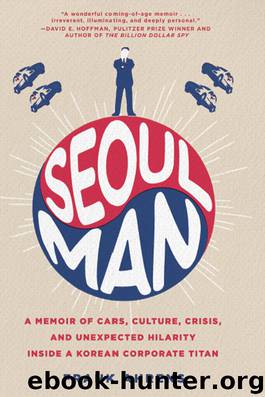Seoul Man: A Memoir of Cars, Culture, Crisis, and Unexpected Hilarity Inside a Korean Corporate Titan by Frank Ahrens

Author:Frank Ahrens
Language: eng
Format: mobi
Publisher: HarperCollins
Published: 2016-08-15T14:00:00+00:00
12
“THIS DOESN’T RATTLE”
It was at the 2011 Detroit Auto Show in America, the auto industry’s taste-making market, that Hyundai had boldly stated that it aspired to become a premium automaker. It set stakes improbably high. Now, nine months later, it was time for Hyundai to make its assault on Europe, where the true targets lay. Hyundai already made cars easily the equal in quality and value of anything the Big Three produced. If we were going to become a true premium brand, it wasn’t adequate to be as good as Ford or Chevy. We had to be as good as Volkswagen, Mercedes, and BMW. We weren’t laughed off the stage in Detroit, but the Germans were a tougher crowd. They guarded the superiority of their cars like Americans guard their freedom: as a birthright and a fundamental component of their national identity.
International motor shows around the world—even the biggest—are usually contained to a connecting series of massive convention center buildings. Frankfurt took it to another level. The 2011 Frankfurt motor show occupied several connected halls; in addition, outside the halls, each German automaker built its own huge stand-alone pavilion. Audi’s was so big, it had its own two-level track inside, where new Audis zipped around for media members to see. I remember walking around the Frankfurt show that year as Europe’s economy and auto sales were falling to pieces—with 50 percent youth unemployment in Spain, Greece defaulting every other day, and even stalwart, sober Germany struggling—and thinking, “What recession?”
This show was terribly important to Hyundai. We were unveiling an all-new version of our best-selling car in Europe, the i30. The i30 was an economical and agreeable if unspectacular five-door hatchback that Hyundai had sold in Europe for years. The new i30 was something altogether different. It was designed to head-on challenge Europe’s gold standard of affordable cars: the Volkswagen Golf.
Plenty of automotive writers will tell you that the Golf is the world’s best car, pound for pound. Not only do they love its practical aspects, such as its roominess and features, but they also love to drive it. The Golf has an auto enthusiast’s tight suspension, a peppy engine, and just the right touch in steering; in automotive parlance, the car gives great “feedback” from the road surface. Drivers agree. The Golf is perennially Europe’s best-selling car. Nominally, the Hyundai i30 was a competitor to the Golf, occupying the same segment, or size, but that’s where the comparisons stopped. No one hated the i30, but no one considered it a serious rival to the Golf. Globally, Volkswagen itself is a monolith, a fact that would surprise most Americans. VW has by far the largest share of the European car market, accounting for more than one-quarter of all sales, and has pulled even with Toyota as the world’s biggest automaker. What’s holding the German titan back from making Toyota the permanent number two automaker is the U.S. VW has never given Americans a compelling reason to buy its cars. With only 2 percent of the U.
Download
This site does not store any files on its server. We only index and link to content provided by other sites. Please contact the content providers to delete copyright contents if any and email us, we'll remove relevant links or contents immediately.
The Meaning of the Library by unknow(2388)
Six Billion Shoppers by Porter Erisman(2229)
Why Nations Fail: The Origins of Power, Prosperity, and Poverty by Daron Acemoglu & James Robinson(2177)
No Time to Say Goodbye(1998)
Red Notice by Bill Browder(1929)
The Economist [T6, 22 Thg9 2017] by The Economist(1844)
Currency Trading For Dummies by Brian Dolan(1792)
Thank You for Being Late by Thomas L. Friedman(1680)
Bitcoin: The Ultimate Guide to the World of Bitcoin, Bitcoin Mining, Bitcoin Investing, Blockchain Technology, Cryptocurrency (2nd Edition) by Ikuya Takashima(1615)
Amazon FBA: Amazon FBA Blackbook: Everything You Need To Know to Start Your Amazon Business Empire (Amazon Empire, FBA Mastery) by John Fisher(1496)
Coffee: From Bean to Barista by Robert W. Thurston(1420)
The Future Is Asian by Parag Khanna(1402)
The Great Economists by Linda Yueh(1391)
Capitalism Without Capital: The Rise of the Intangible Economy by Jonathan Haskel(1342)
Pocket World in Figures 2018 by The Economist(1329)
How Money Got Free: Bitcoin and the Fight for the Future of Finance by Brian Patrick Eha(1322)
Grave New World by Stephen D. King(1317)
The Sex Business by Economist(1280)
Cultural Intelligence by David C. Thomas(1204)
